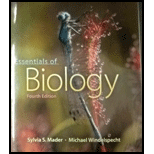
Concept explainers
To explain:
The way nondisjunction changes the number of chromosomes.
Introduction:
The chromosomes separate during cell division. When they don’t separate during the division, it causes a daughter cell to have extra chromosomes and one to have fewer chromosomes. This is known as nondisjunction.
Explanation of Solution
Most of the nondisjunctions that happen in the human body are during the meiosis of gametogenesis. Meiosis is divided into two phases: meiosis I and meiosis II. Each phase has four steps, namely: prophase, metaphase, anaphase, and telophase.
During the anaphase of both the meiotic processes, the chromosomes are separated by being pulled to the opposite poles by the spindle fibre. In anaphase I, the homologous pair is separated and in anaphase II, sister chromatids are separated. In case, the separation does not occur in a daughter cell, there would be two chromosomes instead of one and there would be no chromosome in another daughter cell. The resulting gametes will have abnormal number of chromosomes, some more and some less. If these gametes form the zygote, the child will develop a disorder.
In case, the gamete having two chromosomes is fertilized by the sperm, then the resulting zygote would form trisomy. In case, the gamete having no chromosome is fertilized by the sperm, then the resulting zygote would show monosomy.
Non-segregation (nondisjunction) of chromosomes during cell division leads to a change in the number of chromosomes.
Want to see more full solutions like this?
Chapter 13 Solutions
Essentials of Biology
 Human Anatomy & Physiology (11th Edition)BiologyISBN:9780134580999Author:Elaine N. Marieb, Katja N. HoehnPublisher:PEARSON
Human Anatomy & Physiology (11th Edition)BiologyISBN:9780134580999Author:Elaine N. Marieb, Katja N. HoehnPublisher:PEARSON Biology 2eBiologyISBN:9781947172517Author:Matthew Douglas, Jung Choi, Mary Ann ClarkPublisher:OpenStax
Biology 2eBiologyISBN:9781947172517Author:Matthew Douglas, Jung Choi, Mary Ann ClarkPublisher:OpenStax Anatomy & PhysiologyBiologyISBN:9781259398629Author:McKinley, Michael P., O'loughlin, Valerie Dean, Bidle, Theresa StouterPublisher:Mcgraw Hill Education,
Anatomy & PhysiologyBiologyISBN:9781259398629Author:McKinley, Michael P., O'loughlin, Valerie Dean, Bidle, Theresa StouterPublisher:Mcgraw Hill Education, Molecular Biology of the Cell (Sixth Edition)BiologyISBN:9780815344322Author:Bruce Alberts, Alexander D. Johnson, Julian Lewis, David Morgan, Martin Raff, Keith Roberts, Peter WalterPublisher:W. W. Norton & Company
Molecular Biology of the Cell (Sixth Edition)BiologyISBN:9780815344322Author:Bruce Alberts, Alexander D. Johnson, Julian Lewis, David Morgan, Martin Raff, Keith Roberts, Peter WalterPublisher:W. W. Norton & Company Laboratory Manual For Human Anatomy & PhysiologyBiologyISBN:9781260159363Author:Martin, Terry R., Prentice-craver, CynthiaPublisher:McGraw-Hill Publishing Co.
Laboratory Manual For Human Anatomy & PhysiologyBiologyISBN:9781260159363Author:Martin, Terry R., Prentice-craver, CynthiaPublisher:McGraw-Hill Publishing Co. Inquiry Into Life (16th Edition)BiologyISBN:9781260231700Author:Sylvia S. Mader, Michael WindelspechtPublisher:McGraw Hill Education
Inquiry Into Life (16th Edition)BiologyISBN:9781260231700Author:Sylvia S. Mader, Michael WindelspechtPublisher:McGraw Hill Education





